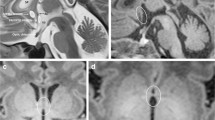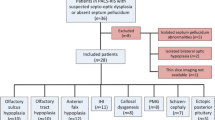Abstract
Background: Primary septal agenesis (PSA) is a rare brain malformation that can be isolated or part of developmental brain abnormalities (holoprosencephaly, septo-optic dysplasia or cortical malformation). Such associated malformation can be subtle, leading to difficulties in the prenatal management of PSA. Moreover, the neurological prognosis of isolated PSA remains debatable. Objective: The aims of the study were to specify the patterns and frequency of brain malformations associated with septal agenesis (SA), to identify the clinical prognosis, and to discuss the aetiology of PSA with the new insights provided by molecular genetics. Materials and methods: The study consisted of a 14-year retrospective review of brain MRI in 34 patients having PSA (mean age, 5 years). Chiasm and optic nerves were not evaluated. Post-hydrocephalus SA or incomplete data were excluded. The clinical data were correlated to the MRI patterns. Results: The study disclosed 82.5% associated lesions with MRI (28/34): 11 neuronal migration disorders, 9 holoprosencephalies (HP), 7 pituitary stalk interruptions, 1 corpus callosum partial agenesis; 17.5% (6/34) of cases were apparently isolated PAS. Clinically, the patients had motor dysfunction in 68% (23/34), mental retardation in 65% (22/34), blindness in 24% (8/34), endocrinological defects in 21% (7/34) and epilepsy in 18% (6/34) of cases. Nine percent of patients (3/34) were neurologically normal (including one with scoliosis and two infants younger than 2 years at the last follow-up). Patients with bilateral cortical anomalies and HP (even if mild) had the worst neurological prognosis. A severe motor impairment was present without evidence of hemispheric anomaly in 12% of patients (4/34). Interestingly, the frontal lobes were involved in 90% of cortical anomalies and HP, supporting the malformative aetiology of PSA. Conclusions: PSA rarely appears isolated and severe psychomotor impairment may occur in apparently isolated forms. These unfavourable results should be highlighted and need to be confirmed by a prospective study.









Similar content being viewed by others
References
Barkovich AJ, Norman D (1989) Absence of the septum pellucidum: a useful sign in the diagnosis of congenital brain malformations. AJR 152:353–360
Kuhn MJ, Swenson LC, Youssef HT (1993) Absence of the septum pellucidum and related disorders. Comput Med Imaging Graph 17:137–147
Cihangiroglu M, Bulut S, Yilmaz S (2002) Isolated septum pellucidum agenesis in an adult. J Neuroimaging 12:89–91
Supprian T, Sian J, Heils A, et al (1999) Isolated absence of the septum pellucidum. Neuroradiology 41:563–566
De Morsier G (1956) Etudes sur les dystrophies crânio-encéphaliques III. Agénésie du septum pellucidum avec malformation du tractus optique: la dysplasie septo-optique. Schweiz Arch Neurol Neurochir Psychiatr 77:267–292
Hoyt WF, Kaplan SL, Grumbach MM, et al (1970) Septo-optic dysplasia and pituitary dwarfism. Lancet 1(7652):893–894
Wagner AL, Murtagh FR, Hazlett KS, et al (1997) Measurement of the normal optic chiasm on coronal MR images (published erratum appears in AJNR 1997; 18: 1396). AJNR 18:723–726
Barkovich AJ, Fram EK, Norman D (1989) Septo-optic dysplasia: MR imaging. Radiology 171:189–192
Raybaud C, Girard N, Levrier O, et al (2001) Schizencephaly: correlation between the lobar topography of the cleft(s) and absence of the septum pellucidum. Childs Nerv Syst 17:217–222
Barkovich AJ, Norman D (1988) MR imaging of schizencephaly. AJR 150:1391–1396
Denis D, Chateil JF, Brun M, et al (2000) Schizencephaly: clinical and imaging features in 30 infantile cases. Brain Dev 22:475–483
Golden JA (1999) Towards a greater understanding of the pathogenesis of holoprosencephaly. Brain Dev 21:513–521
Sarnat HB, Flores-Sarnat F (2001) Neuropathologic research strategies in holoprosencephaly. J Child Neurol 16:918–931
Oba H, Barkovich AJ (1995) Holoprosencephaly: an analysis of callosal formation and its relation to development of the interhemispheric fissure. AJNR 16:453–460
Simon EM, Hevner RF, Pinter JD, et al (2002) The middle interhemispheric variant of holoprosencephaly. AJNR 23:151–156
Barkovich AJ, Quint DJ (1993) Middle interhemispheric fusion: an unusual variant of holoprosencephaly. AJNR 14:431–440
Siatkowski RM, Sanchez JC, Andrade R, et al (1997) The clinical, neuroradiographic, and endocrinologic profile of patients with bilateral optic nerve hypoplasia. Ophthalmology 104:493–496
Roessler E, Muenke M (1998) Holoprosencephaly: a paradigm for the complex genetics of brain development. J Inherit Metab Dis 21:481–497
Brunelli S, Faiella A, Capra V, et al (1996) Germline mutations in the homeobox gene EMX2 in patients with severe schizencephaly. Nat Genet 12:94–96
Barkovich AJ, Kjos BO (1992) Schizencephaly: correlation of clinical findings with MR characteristics. AJNR 13:85–94
Dattani ML, Martinez-Barbera J, Thomas PQ, et al (2000) Molecular genetics of septo-optic dysplasia. Horm Res 53 [Suppl 1]:26–33
Warburg M, Bugge M, Brondum-Nielsen K (1995) Cytogenetic findings indicate heterogeneity in patients with blepharophimosis, epicanthus inversus, and developmental delay. J Med Genet 32:19–24
Acknowledgements
Special thanks to Sylvie Odent for her references about the genetics of holoprosencephaly, to our colleagues in the paediatric neurology and paediatric endocrinology departments and to Pascale Zerbini for preparing the manuscript.
Author information
Authors and Affiliations
Corresponding author
Additional information
This work was awarded the Jean Pierre Monnier prize in 2003.
Rights and permissions
About this article
Cite this article
Belhocine, O., André, C., Kalifa, G. et al. Does asymptomatic septal agenesis exist? A review of 34 cases. Pediatr Radiol 35, 410–418 (2005). https://doi.org/10.1007/s00247-004-1378-2
Received:
Revised:
Accepted:
Published:
Issue Date:
DOI: https://doi.org/10.1007/s00247-004-1378-2




